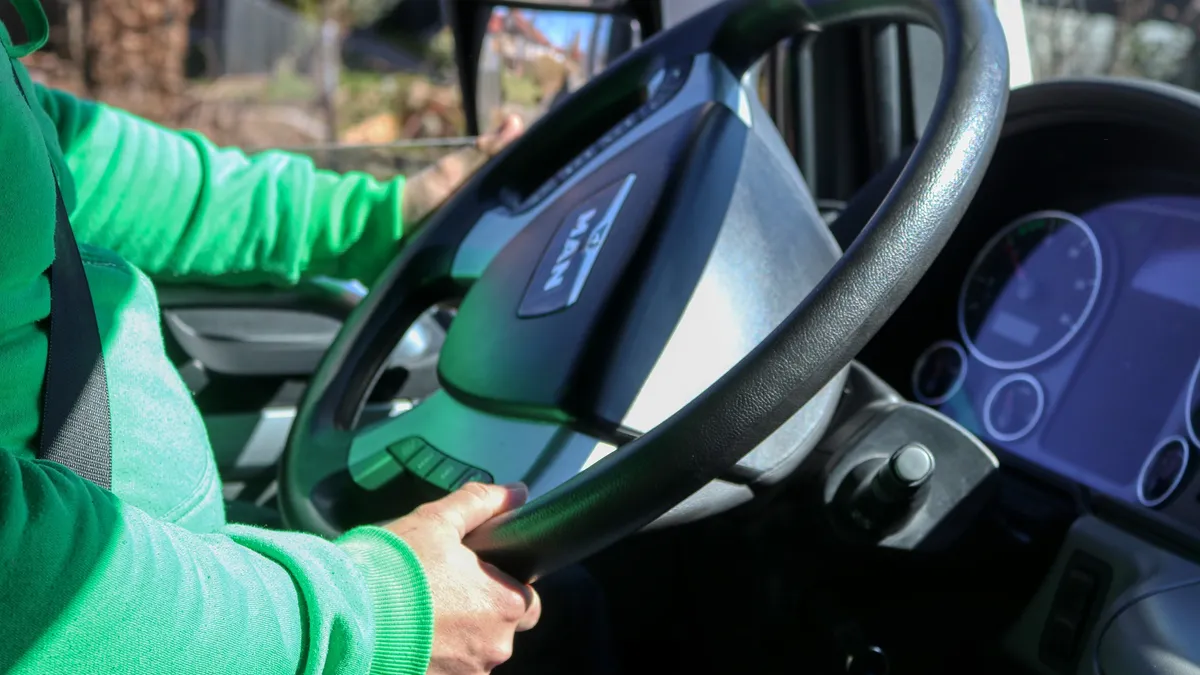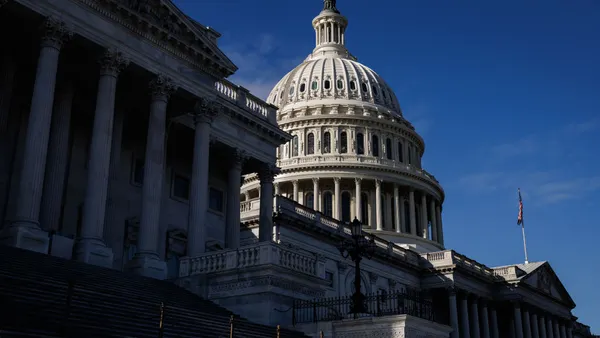The FMCSA released its final HOS rule in May. Fleets had until the end of September to get acquainted with the four major changes, before the rule was officially implemented.
At the agency's third HOS Q&A webinar Thursday, fleets had questions about all four areas of change. Though the changes can be boiled down to one or two sentences, some aspects and scenarios are complex, and the minutiae could be the difference between compliance and a violation.
Here are some of the questions and answers covered by three FMCSA officials: Office of Enforcement Director Joe DeLorenzo, Transportation Specialist Rich Clemente and Attorney Advisor at the Office of the Chief Counsel Bill Varga.
Short-haul exception
The HOS final rule expands the short-haul exception from 100 air miles to 150 air miles and allows for a 14-hour work shift instead of 12-hour.
What happens if a driver can't start and finish in the same day, due to conditions outside of my control?
In that situation, for that trip that day, the driver should fill out a paper log, DeLorenzo said. So long as the driver does not need to fill out a paper log more than eight times in a rolling, 30-day period, that driver remains exempt from the ELD mandate.
If a fleet has multiple or consistent routes longer than 150 air miles, that fleet may want to consider giving those routes to a single driver that has an ELD, DeLorenzo said.
What should be used as the start and end locations?
The 150 air miles begin wherever the transport begins, be it a yard or a driver's home, DeLorenzo said.
What happens if the short-haul driver encounters hazardous driving conditions and is unable to return within 14 hours?
Fill out a record of duty status for that day, DeLorenzo said.
There is a possibility that the required 30-minute break after eight hours or driving would come into play, though that is "highly unlikely," he said.
If a driver no longer qualifies under the short-haul exception and needs to become ELD-compliant, when can that driver go back to being a short-haul driver?
That goes back to the rule that allows for eight paper logs in a rolling, 30-day period. Once a driver is at eight or fewer, he or she qualifies as a short-haul driver.
Adverse driving conditions
The HOS final rule expands the driving window during adverse driving conditions by up to two hours.
Do accidents involving the driver qualify as an adverse driving condition?
"The answer is, 'No,'" Clemente said. "If the driver is involved ... in an incident on the road, that would not be classified as an adverse driving [condition] under the current provision."
Can a driver use this exception, even if the adverse driving condition is clear when the driver arrives at the location where the condition occurred?
The exception is meant to be used in scenarios when drivers are delayed due to adverse driving conditions, Clemente said.
Varga said if a driver were stuck in traffic due to an adverse driving condition ahead, that would be an appropriate use, though he stressed that the exception gives only two extra hours.
Are drivers required to annotate the type of adverse driving conditions encountered on their ELDs?
Regulation does not require drivers to annotate the type, Clemente said.
"But what they should do is annotate on their ELD ... that an adverse driving condition did occur and that might be the reason for additional driving hours on their ELD or their logbook," he said.
When should a driver record the exception? When the condition occurs or at the end of the day when I am over hours, due to the condition?
Clemente recommended annotating when the condition occurs. DeLorenzo agreed.
Having those extra details will help prove compliance, if a driver is questioned about those particular extra hours at a later time, DeLorenzo said, though he does not recommend annotating while driving down the road. "But the next opportunity where you have the ability to do that, certainly, that would be the recommendation."
No other proof of the adverse driving condition is required, under the regulation.
If a truck stop at which a driver was planning to stop is unexpectedly closed, does it count as an adverse driving condition?
It depends, Varga said. If a truck stop is closed because of an unforeseen adverse driving condition, that would count. But if it were closed for an unrelated reason, such as a power outage, that doesn't technically fit the definition.
If a driver sees a forecast that warns of a pending storm, but the driver elects to proceed anyway, would the driver be able to use the adverse-conditions rule if he or she ends up getting delayed by the storm?
It depends on when the driver was made aware of the condition, Varga said. If the driver was made aware before starting, or coming off a sleeper-berth break, they would not be able to use the rule. But if it was unforeseen, the rule could apply.
30-minute break period
The HOS final rule requires a break of at least 30 consecutive minutes after eight cumulative hours of driving time. The break can be fulfilled by an on-duty/not-driving period.
Can the 30-minute break be fulfilled by a combination of driving statuses?
Yes, Clemente said. "[A driver] can be off duty for 10 minutes, on-duty/not-driving for 20, as long as the 30 was consecutive."
Can yard moves and roadside inspections count toward the 30-minute break?
This is a frequently asked question, Clemente said, and the answer is, "Yes." The requirement for consecutive is key here, though. If an inspection takes a shorter amount of time and the driver goes back out on the highway, it won't count.
Does a driver need to note the break on his or her log?
No, Clemente said, because it should already show as a consecutive 30 minutes of break time, whatever the duty status may be.
Does personal conveyance count toward the break?
"As we all know, personal conveyance is not a rule, per se, it's more guidance," Clemente said. "But if it is correctly used, it is considered to be off-duty time."
But, in that case, it is in the drivers best interest to annotate that in the log, Varga said. The truck is still moving, so it won't show clearly in the log that it was personal conveyance.
Sleeper-berth exception
The HOS final rule allows a driver to meet the 10-hour minimum off-duty requirement by spending at least 7 hours of that period in the berth, combined with a minium off-duty period of at least two hours spent inside or outside the berth. The two periods must total at least 10 hours, and neither counts against the 14-hour driving window.
How should a driver calculate the off-duty time to ensure compliance?
If a driver decides to comply with the sleeper-berth exception by using a split, it can be a bit complicated to calculate driving and on-duty hours.
"For most of you, your ELD is going to do this for you," DeLorenzo said. "But the key point is that three hours and then seven hours [for example] aren't counted against your 14 hours."
A driver takes 10 hours of rest and then begins driving at midnight, DeLorenzo gave as a hypothetical scenario. That driver has a brand new clock to start the day. Say the driver is then on-duty from midnight until 9 a.m. (nine hours), then rests from 9 a.m. until 1 p.m. (three hours). After that, the driver has five hours of on-duty time left until the 14-hour window closes. Once the 14 hours are up, the driver would need to begin the seven hours of rest (to reach 10 hours).
The key is the three-hour rest period from 9 a.m. to 1 p.m. only stops the clock if it's paired with a seven-hour rest period. So, if the driver from that scenario gets stopped for an inspection, for example, that takes him or her over the 14-hour window, that's a violation. And once the violation hits, the driver runs out of time to take the seven-hour rest, which means the three-hour rest period cannot pair up to equal 10 and is, therefore, added to the overflow of hours.
What if a driver takes two shorter breaks of two hours, before taking a longer break of eight hours in sleeper berth? Would both two-hour breaks stop the clock and count as part of the split?
"The short answer is, 'No,'" DeLorenzo said. Only one can count. So, in that scenario, the driver should determine which of the breaks is going to be the most advantageous and allow the most flexibility and availability of hours, he said.











